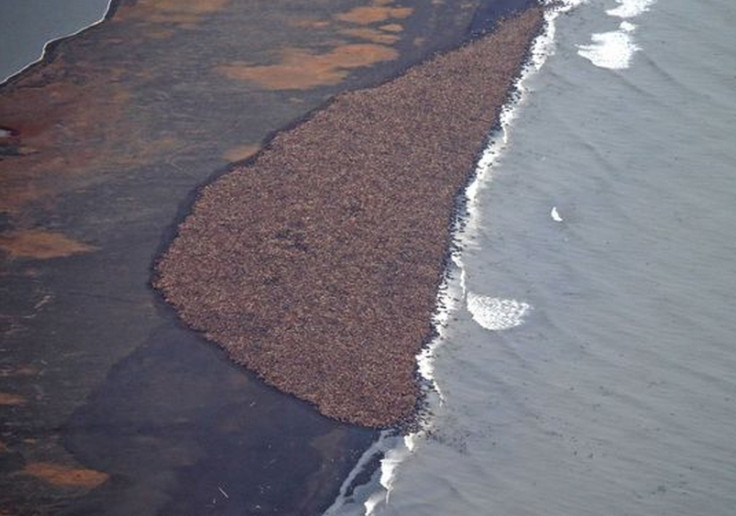35,000 Walruses Stranded on Alaska Beach Force US Government to Reroute Flights

The rapid melting of Arctic sea ice has forced around 35,000 Pacific walruses to retreat to the Alaska shoreline, forcing flights to be rerouted to avoid a stampede of the animals.
Massive melts due to a warming Arctic and climate change has led to ice retreating from the continental shelf, forcing the walruses to move from the ice to areas on shore because of their inability to dive for food in greater depths.
Walruses are skittish and are not usually closely packed together, spending 80% of their time in water. The animals, which can grow to almost 10ft long, can only dive to around 260ft.
To avoid a stampede, the Federal Aviation Administration has rerouted flights, asking pilots to remain above 2,000ft and half a mile away from the animals. Helicopters are to stay above 3,000ft and a mile away because they are noisier.
The media and intrigued locals have also been warned to stay away from the herd.
"The government and local communities are respectfully asking you to leave the haul-out alone," Joel Garlich Miller, a walrus biologist with the US Fish and Wildlife Service, told Reuters.
If a stampede does occur, younger pups are at risk of being crushed as adult animals rush for the safety of the sea. Around 50 walrus carcasses have been observed in the area, possibly as a result of a crush.
Walruses in the Chukchi sea - a marginal sea of the Arctic Ocean - around this time of year are generally females and pups and are at greater risk of being trampled to death.
Researchers from the National Oceanic and Atmospheric Administration have said the walruses came to shore near the village of Point Lay, around 700 miles north of Anchorage, at the weekend.
Unlike seals, walrus cannot swim indefinitely and must rest. They use their tusks to "haul out" - to pull themselves onto ice or rocks.
This is the largest known exodus of walruses to dry land ever seen in the Arctic under US control. Last month, USA Today reported that the Arctic sea ice had shrunk to its sixth-lowest level on record, according to data from the National Snow and Ice Data Center.
"One of the differences between this haul-out and other ones is the sheer size and number of animals coming to shore," said Chadwick Jay, a research ecologist in Alaska with the US Geological Survey.
"Those animals have essentially run out of offshore sea ice, and have no other choice but to come ashore," he said, adding that the ice dissipation was likely attributed to changes stemming from global climate change.
© Copyright IBTimes 2025. All rights reserved.






















